




Your support is critical to our success.
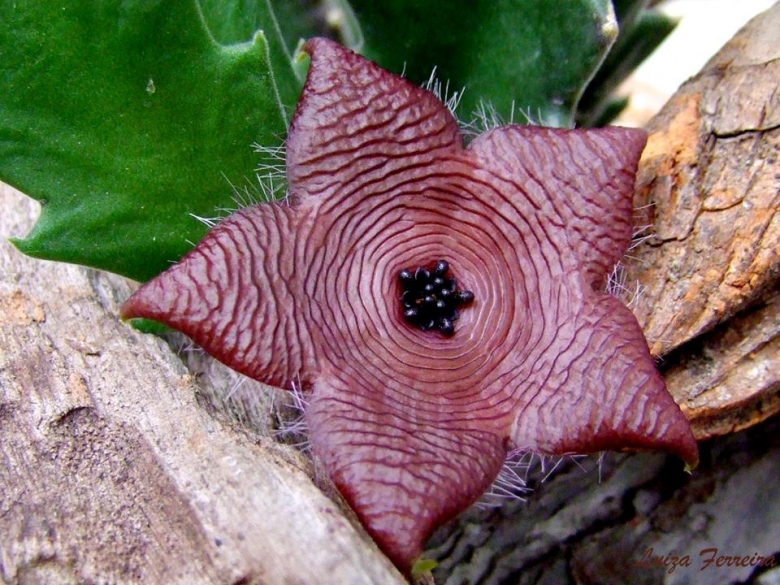
Origin and Habitat: Stapelia clavicoronaSN|28119]]SN|30226]] is a rare species that grows around Wyllie's Poort in the Zoutpansbergen, sporadic from the Nzhelele Dam west to the Sand River Red, Limpopo Province (northern Transvaal) of South Africa. The only known place where it has been found is only a few square kilometres.
Type locality: South Africa, Limpopo Province, Soutpansberg, Wylie's Pooit.
Habitat and ecology: This species grows in soils derived from quartzite on hot, rocky ledges or steep rocky slopes, along the central ridges of the mountain range, preferring a sheltered position under cover of such shrubs as Portulacaria afraSN|18165]]SN|18165]]. The plant is listed as Vulnerable by Hilton-Taylor (1996). The type community at Wylie's Poort has been severely depleted by over-collecting and possibly by natural factors. The plants are adversely affected by black rot and sometimes pulled out by animals. Habitat degradation and over-grazing have led to the demise of at least one known population. There has also been an observed decline in the number of plants in some communities as a result of drought. Botanically the Zoutpansbergen mountains holds many remarkable succulents. For instance: Caralluma rogersiiSN|30615]]SN|29221]], Caralluma grandidens, Caralluma carnosaSN|29221]]SN|30615]], Stapelia kwebensisSN|30226]]SN|28119]], Stultitia Tapscottii, Huernia whitesloaneana , Huernia nouhuysii, Orbeanthus conjunctusSN|30507]]SN|30507]], Thorncroftia succulenta, Euphorbia aeruginosaSN|27158]]SN|27158]], Aloe angelica, Aloe petrophila and Ceropegia cimiciodoraSN|29271]]SN|29271]] are endemic to these mountains.
Synonyms:
- Stapelia clavicorona I.Verd.
- Gonostemon clavicorona (I.Verd.) P.V.Heath
ENGLISH: Zoutpansberg stapelia
Description: Stapelia clavicoronaSN|19218]]SN|30226]] consist of 1-10 (occasionally up to 100), fairly robust stems (by far one of the most robust stems in the genus) that are deeply indented between the angles. Flower too, is one of the most unusual of all staps.
Derivation of specific name: It was first collected in 1931 and the specific epithet refers to the club-shaped (Latin: clava, the club of Hercules) inner corona lobes.
Stems: Robust, mm tall, 12-25(-30) cm long, square, fuzzy with compressed angles armed with teeth ending with an up to 2 mm prominent thick white tip and sides deeply furrowed. Stems are olive-green and turn reddish in the dry season. Older stems become corky and white.
Inflorescence: Flowering successively from a short peduncle; peduncle usually situated about midway up the stem, 6-7 mm long, 3.5 mm across.
Flowers: Star-shaped, relatively small (c. 50-60 mm in diameter). Pedicel, pubescent. Sepal lobes triangular, 5-6 o2.5 mm long, pubescent. Corolla without an annulus, outside velvety pubescent, inside glabrous with a few white hairs, disc and lobes pale pinkish green, pik-violet, dull rose to light yellow marked with purple-brown transverse lines. Lobes broadly ovate, 16-18 mm long, c 15 mm broad, margins partly ciliate (with club-shaped hairs). Corona raised on a 5-ribbed pedicel. Outer lobes 2-horned 2.5 mm long, 1.25 mm wide, suberect, fleshy, dark purple almost black. Inner corona dark purple, being divided into two clavate lobes c. 3 mm long
Fruit: A two-homed pubescent follicle.
Blooming season: Autumn.
Related species: S. clavicorona is not closely related to any other species within the genus, nonetheless it is similar in growth form to Stapelia gettliffei, and Stapelia giganteaSN|30226]]SN|19218]], but it is differentiated by its smaller flowers and by its unique corona morphology.
Bibliography: Major references and further lectures
1) Clive Innes “Complete Handbook of Cacti and Succulents” Van Nostrand Reinhold Company, 01 dic 1981
2) Verdoorn "Flowering Plants of Southern Africa" 11: plate 407 1931
3) Victor, J.E. 2006. "Stapelia clavicorona I.Verd." National Assessment: Red List of South African Plants version 2014.1. Accessed on 2015/02/21
4) Norbert Hahn “Endemic Flora of the Soutpansberg” November 2002 <http://www.soutpansberg.com/endemic_flora/pdf/endemic_flora_soutpansberg.pdf> Accessed on 2015/02/21
5) White & Sloane. “The Stapelieae” edn 2. Abbey San Encino Press, 1937
6) Leach, L. C. "A revision of Stapelia" L. Excelsa Taxon. Ser. 3: 1–157 1985
7) Carl August Lückhoff “The stapelieae of Southern Africa” A. A. Balkema, 1952
8) Focke Albers, Ulrich Meve “Illustrated Handbook of Succulent Plants: Asclepiadaceae: Asclepiadaceae” Volume 4 Springer Science & Business Media, 2002
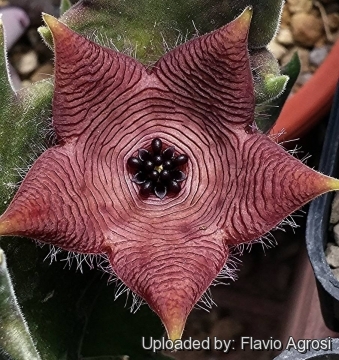
Stapelia clavicorona Photo by: Flavio Agrosi

Stapelia clavicorona Photo by: Luiza Ferreira
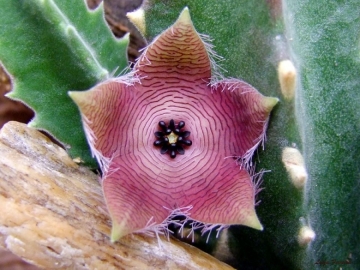
Stapelia clavicorona Photo by: Luiza Ferreira
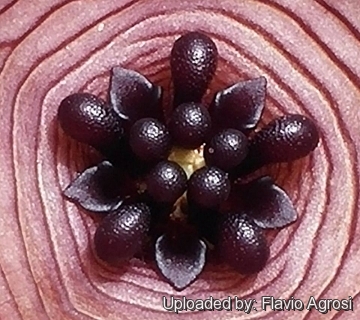
Stapelia clavicorona Photo by: Flavio Agrosi
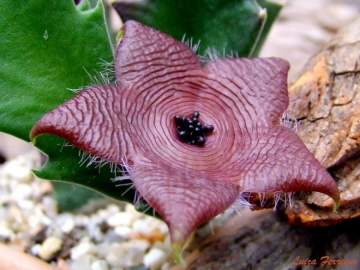
Stapelia clavicorona Photo by: Luiza Ferreira
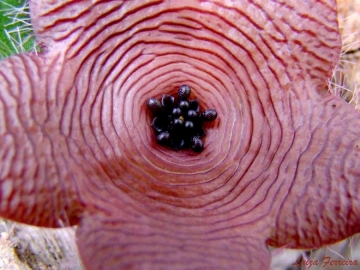
Stapelia clavicorona - Soutpan, NW Soutpansberg .Limpopo Prov. PvB7003 Photo by: Luiza Ferreira
Cultivation and Propagation: Stapelia clavicoronaSN|30226]]SN|30226]] aren't difficult to grow and flower. Fertilize once during the growing season with a balanced fertilizer diluted to ½ the strength recommended on the label. They need a well-drained potting-mix and can withstand extreme heat but avoid direct sun in summer. Best in partial sun or light shade.
Frost Tolerance: They need a cool, dry rest period in winter but keep above 10°C and avoid any frost.
Propagation: They are propagated by stem cuttings. Take cutting in spring when new growth begins. Let cuttings callus up for 2-3 weeks before planting.
| Your Actions | |
|---|---|
| Back to Stapelia index | |
| Back to Asclepiadaceae index | |
 |
Back to Succulents Encyclopedia index |
Privacy stantement - Terms and conditions - How to cite - About us - Feedback - Donate



